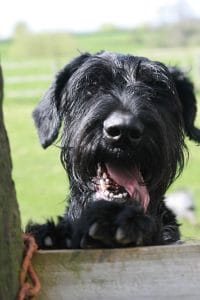The winner of Crufts 2008 – The Giant Schnauzer

History
All sizes of Schnauzer were developed in Germany in the 19th century on the farmlands of Wurttemberg and Bavaria. The Giant Schnauzer (known in Germany as Riesenschnauzer) was developed by crossing the standard variety, which was developed first, with the black Great Dane and other herding breeds, for the purpose of herding and guarding. Until the 20th century, Giant Schnauzers were used for these agricultural functions, until their propensity for police and military training was noticed and used during World War I.
Physical Attributes
As the name suggests, Giant Schnauzers look like larger versions of the standard Schnauzer, weighing between 70 and 100 pounds and standing 23.5 to 27.5 inches tall. Bred for farm work, these are sturdy, hard-working dogs with a squarely proportioned build, an erect, rectangular head and muzzle as wide as the top of the head. The ears are raised and either cropped (although this is less becomming less common and, in some countries, illegal) or folding naturally into a V-shape.
Their tail is high and, in some countries, docked, although again this is now less popular and illegal in some territories. They are double-coated with a soft undercoat and a wiry, hard, long outer coat which is either salt and pepper or all black in colour. The average lifespan is 9 to 12 years.
Grooming
Grooming Giant Schnauzers can be time consuming – show dogs of the breed need to be hand stripped approximately once a month, which is best done by a professional groomer. For companion dogs, trimming with clippers regularly is sufficient. Bred to work hard, this breed needs vigorous daily exercise including long, brisk walks and a fast game, jog or agility training session. Giant Schnauzers also have tremendous pulling strength and can get good exercise by pulling a wagon.

Personality
Training is crucial to teach this large, rambunctious dog the rules and its place in the household; advanced training is recommended to keep its bright mind busy and its assertive impulses in check. Puppies should be socialized well with lots of different types of people and pets in order to suppress their watchdog instincts. Giant Schnauzers can be dog-aggressive, so early socialization is especially important, as is positive, fear-free and challenging training.
Giants are loyal and devoted pets, although young dogs of the breed have to be taught their limits when it comes to playing with children and smaller pets. Older children find great companions in this breed.
As they are a large breed, Giant Schnauzers are prone to hip and elbow dysplasia along with eye disorders, hypothyroidism and seizure disorders. Toe cancer is also relatively prominent in the breed so owners should be sure to check their dog’s feet regularly.



I have a miniature schnauzer and she is the love of my life – intelligent, protective, active and a superior companion – her name is Sade and her favorite toy and trick is to take an empty plastic water bottle and unscrew the cap – she has mastered this trick and everyone who gets to see her do this, loves it.